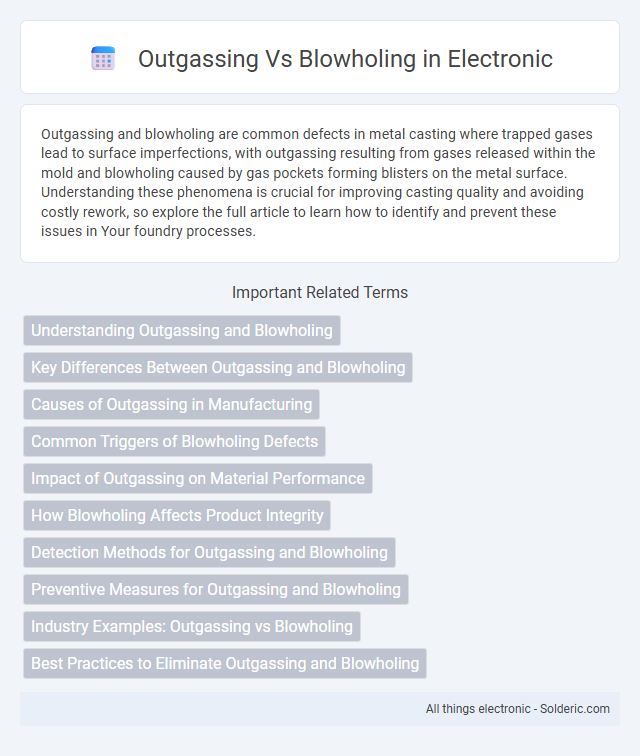Outgassing and blowholing are common defects in metal casting where trapped gases lead to surface imperfections, with outgassing resulting from gases released within the mold and blowholing caused by gas pockets forming blisters on the metal surface. Understanding these phenomena is crucial for improving casting quality and avoiding costly rework, so explore the full article to learn how to identify and prevent these issues in Your foundry processes.
Comparison Table
| Aspect | Outgassing | Blowholing |
|---|---|---|
| Definition | Release of trapped gases from a material during heating or molding. | Formation of hollow cavities or holes on a surface caused by gas entrapment. |
| Cause | Trapped moisture, solvents, or gases escaping during temperature rise. | Gas pockets trapped beneath a material's surface during solidification. |
| Materials Affected | Plastics, metals, composites. | Injection molded plastics, cast metals. |
| Visual Appearance | Surface bubbles or gas release signs. | Visible holes or cavities (blowholes) on the surface. |
| Impact on Quality | Surface defects, reduced mechanical properties. | Structural weaknesses, compromised aesthetics. |
| Prevention Methods | Proper drying, degassing molds, controlled temperature rise. | Optimized molding parameters, venting, improved material flow. |
Understanding Outgassing and Blowholing
Outgassing is the release of trapped gases from molten metal during solidification, often causing porosity and surface defects in castings. Blowholing occurs when gas pockets form cavities or voids within the metal, typically as a result of excessive outgassing. Proper control of melt quality, degassing techniques, and mold design minimizes outgassing and prevents blowholing, improving casting integrity.
Key Differences Between Outgassing and Blowholing
Outgassing involves the release of trapped gases from molten metal or materials during solidification, leading to porosity or defects inside the cast structure. Blowholing specifically refers to the formation of cavities or holes on the metal surface caused by gas entrapment, typically when gases fail to escape before solidification. Understanding these key differences helps you control material quality by selecting appropriate casting techniques and improving degassing processes.
Causes of Outgassing in Manufacturing
Outgassing in manufacturing primarily occurs due to the release of trapped gases within materials during heating or curing processes, often caused by moisture, volatile compounds, or residual solvents. These gases escape and create bubbles or voids on the surface, compromising product quality. Understanding the causes of outgassing can help you implement better material selection and processing techniques to minimize defects.
Common Triggers of Blowholing Defects
Blowholing defects commonly occur due to trapped gases or air pockets during the solidification process, often triggered by moisture in the mold, contaminated metal, or excessive pouring temperatures. You can prevent blowholing by controlling the drying of molds, maintaining proper melt cleanliness, and optimizing pouring parameters to reduce gas entrapment. Proper ventilation and degassing techniques also minimize the risk of blowholes, ensuring a higher quality casting with fewer defects.
Impact of Outgassing on Material Performance
Outgassing causes the release of trapped gases within materials, leading to surface defects and reduced structural integrity. These released gases can create weak spots that promote blowholing, resulting in voids and imperfections throughout the material. The compromised material performance due to outgassing affects durability, mechanical strength, and overall product reliability.
How Blowholing Affects Product Integrity
Blowholing creates small cavities or holes in products due to trapped gas during manufacturing, directly compromising structural integrity and surface finish. Outgassing, a related process, releases trapped gases from materials but typically does not result in visible defects like blowholes. Your product's durability and appearance can be significantly affected by blowholing, leading to potential performance failures and reduced aesthetic quality.
Detection Methods for Outgassing and Blowholing
Detection methods for outgassing and blowholing primarily involve visual inspection, ultrasonic testing, and radiographic imaging to identify gas porosity and surface defects in metal castings. Gas chromatography and mass spectrometry analyze the chemical composition of gases released during outgassing, while dye penetrant testing and X-ray computed tomography (CT) provide detailed insights into blowhole formation and internal voids. Your quality control process benefits from combining these techniques to detect and differentiate outgassing and blowholing effectively, ensuring enhanced casting integrity.
Preventive Measures for Outgassing and Blowholing
Preventive measures for outgassing and blowholing in metal casting include thorough drying of molds and cores to eliminate moisture that causes gas formation. Using low-moisture refractory materials and vacuum degassing molten metal reduces trapped gases, minimizing porosity defects. Proper venting and controlled pouring temperature further prevent gas entrapment and ensure high-quality castings.
Industry Examples: Outgassing vs Blowholing
Outgassing commonly affects industries such as aerospace and electronics manufacturing, where volatile compounds release trapped gases during vacuum or high-temperature processes, potentially compromising component integrity. Blowholing frequently appears in metal casting industries, particularly in aluminum and steel production, where trapped gases form surface or internal cavities that weaken structural quality. Your understanding of these phenomena can enhance quality control by targeting specific causes unique to each industry's material and process conditions.
Best Practices to Eliminate Outgassing and Blowholing
To eliminate outgassing and blowholing in metal casting, ensure thorough mold drying and proper venting to allow trapped gases to escape. Use low-moisture materials and control pouring temperatures to minimize gas formation during solidification. Your best practice includes optimizing mold composition and employing vacuum systems to reduce gas entrapment and improve casting quality.
Outgassing vs blowholing Infographic

 solderic.com
solderic.com